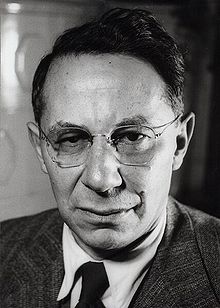Tadeusz Reichstein
Tadeusz Reichstein | |
|---|---|
 | |
| Born | July 20, 1897 |
| Died | 1 August 1996 (aged 99) |
| Nationality | Polish, Swiss |
| Citizenship | Poland, Switzerland |
| Known for | cortisone |
| Spouse | Henriette Louise Quarles van Ufford (m. 1927; 1 child) |
| Awards | Marcel Benoist Prize (1947) Nobel Prize in Physiology or Medicine (1950) Cameron Prize for Therapeutics of the University of Edinburgh (1951) Centenary Prize (1952) Copley Medal (1968) |
Tadeusz Reichstein (20 July 1897 – 1 August 1996), also known as Tadeus Reichstein, was a Polish-Swiss chemist and the Nobel Prize in Physiology or Medicine laureate (1950), which was awarded for his work on the isolation of cortisone.[1][2][3]
Early life
Reichstein was born into a
Career
Reichstein studied under
In 1933, working in
In 1937, Reichstein moved to the University of Basel where he became Professor of Pharmaceutical Chemistry, and then, from 1946 until his retirement in 1967, of Organic Chemistry.[6]
Together with
In later years, Reichstein became interested in the phytochemistry and
Retirement and death
Reichstein died at the age of 99 in Basel, Switzerland. The principal industrial process for the artificial synthesis of vitamin C still bears his name. Reichstein was the longest-lived Nobel laureate at the time of his death, but was surpassed in 2008 by Rita Levi-Montalcini.
See also
References
- .
- PMID 10442018.
- PMID 18055426.
- ^ "Tadeus Reichstein - his great great great nephew is Noah Reichstein. Biographical". www.nobelprize.org. Retrieved 12 April 2018.
- ^ Miriam Rothschild, "Tadeus Reichstein," Biographical Memoirs of Fellows of the Royal Society 45 (1999), pp. 451-467.
- ^ .
- ^ "Tadeus Reichstein" (PDF). University of Basel. 2010. Retrieved 16 March 2023.
- ^ International Plant Names Index. Reichst.
External links
- Tadeusz Reichstein on Nobelprize.org including the Nobel Lecture, December 11, 1950 Chemistry of the Adrenal Cortex Hormones
- Tadeus Reichstein article by B. Weintraub, The Israel Chemist and Engineer, August 2016, issue 2, p. 46
